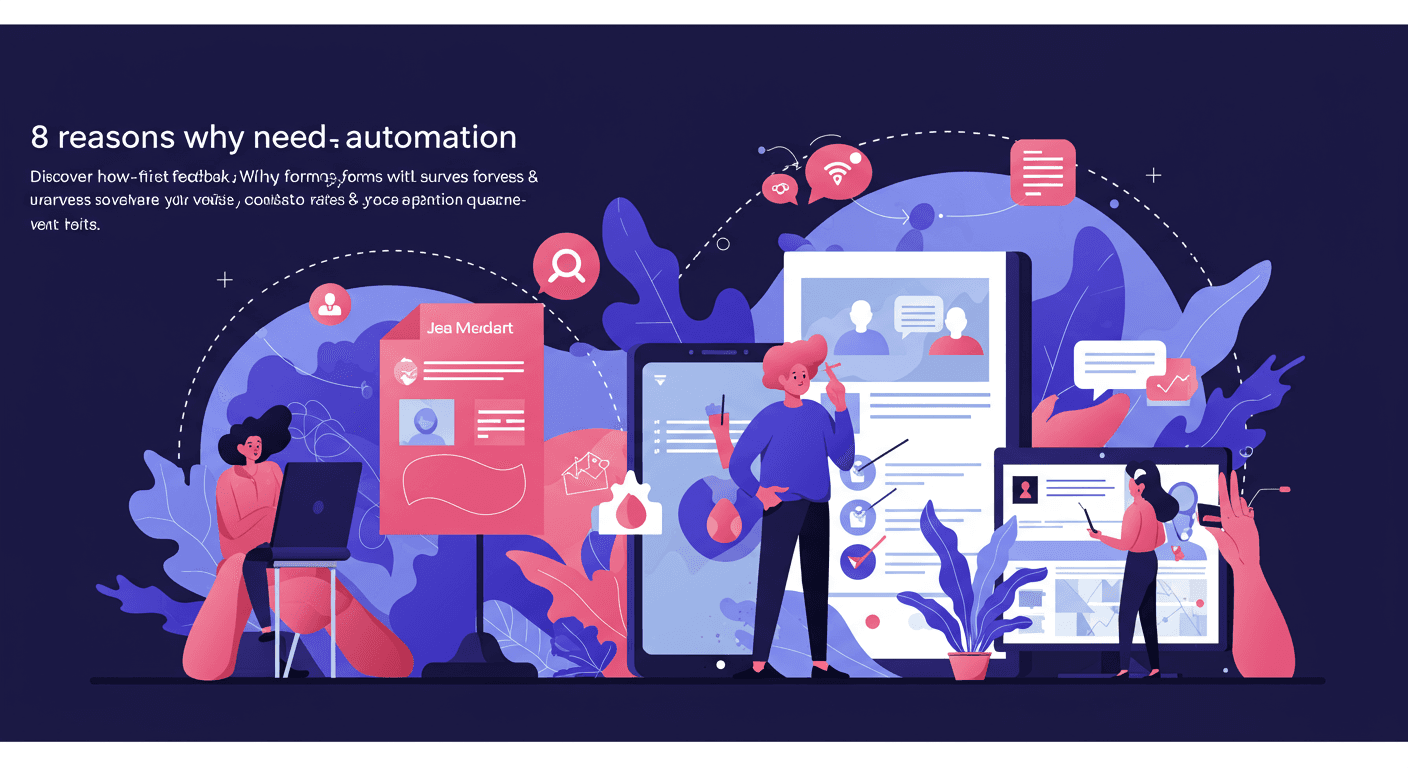Feedback communication is vital for both capturing and providing important information to employees within the company and to teams. It also plays a significant role in communicating with customers. In today's fast-paced business environment, having a streamlined and organized approach to feedback is more crucial than ever.
A good flow of information allows managers to boost employee satisfaction and efficiency. It also enables entire companies to raise the quality of products and services by listening to customer opinions, reviews, and comments. In the age of instant information, customer feedback can make or break a brand.
That's why in today's article, we will cover topics mainly related to why feedback communication is essential and how to use the information gained from customers to drive meaningful improvements. We'll explore how AI-powered tools can revolutionize the feedback process.
Let's get started!
What is Feedback Communication?
Feedback communication is a process of exchanging information and ideas about the work that has been done in order to improve it. It can be used to provide suggestions to individuals or groups and take many different forms, such as written notes, emails, or face-to-face conversations. Modern feedback systems also include digital surveys, real-time chat, and even AI-driven analysis. This communication can help ensure that the data is received and understood and that it’s used to enhance the work being done.
But feedback communication is also an incredibly crucial part of a company's customer relations. Without it, it's almost impossible to raise the quality of products sold and services offered or develop the company and stay in the competitive market. In today's competitive landscape, businesses must prioritize gathering and acting upon customer feedback to maintain a competitive edge.
Their insights, issues, and all input shared about their experiences matter for your company's performance, so having feedback communication professionally organized is more than a must. It's the backbone of customer-centricity and continuous improvement.
Why is Feedback Communication Important?
Let's start with the fact that feedback communication is a key element in the company. Managers need to know how to handle and encourage employees to proactively give insights and opinions. This is essential because:
#1 It helps people to learn and grow

When people are given feedback, it can help them learn and grow. When it’s presented correctly, it can help people identify their strengths and weaknesses and work to improve on the areas where they need it. Therefore, good communication has a positive effect on the development of employees and greater awareness of products among customers. Constructive feedback fosters a culture of continuous learning and development.
#2 It allows people to resolve problems and boost their work
Feedback communication allows team members to give information about their performance, for example through an employee self-service app, and to receive valuable advice from their superiors. So, if there are any problems that disrupt, for example, the workflow, thanks to good communication, it can be put back on track. It will also make employees feel heard so they can be more willing to work in an environment where their voice matters. Open communication channels enable rapid problem-solving and increased efficiency.
#3 It raises the quality of work life for everyone involved
In addition, feedback communication allows employees to learn from each other and develop their teamwork skills. But it's not only about what employees can do but also how they feel in the company. For example, you can ask about benefits that would improve their job satisfaction or how would a well-implemented safety and health program affect employee retention? Prioritizing employee well-being leads to increased job satisfaction and retention.
Therefore, it can help ensure that employees are motivated and satisfied with their work rather than perhaps just caring about how much money they make. This will lead to relationships at work being more durable and lasting. And by providing comments in a way that is both constructive and positive, individuals can develop a positive working atmosphere among team members. A positive work environment enhances collaboration and innovation.
#4 It increases team productivity
Another benefit of effective feedback communication is that it can increase team productivity. When individuals know what needs to be done and how they can help improve the situation, they are more likely to put effort into their work. That’s why every input should be specific, timely, and actionable in order to ensure that it is effectively received and used. Clear communication of goals and expectations drives productivity and efficiency.
#5 It allows you to understand your clients better
Feedback communication is an essential tool for any organization, and it's imperative in the customer service field. By providing suggestions in a timely and consistent manner, your team can better understand your clients' needs and expectations. This knowledge can help you strengthen your interactions with them and ultimately create a better bond between customers and your company. Understanding customer needs leads to improved products, services, and customer loyalty.

Photography by Antoni Shkraba on Pexels
#6 It increases communication within the team
Feedback communication is an integral part of team development as well. It allows individuals to communicate their thoughts and concerns directly to one another and helps enhance overall communication within the team. By providing insights regularly, team members can identify and address problems early on, preventing them from becoming more widespread and challenging to fix. Such information also allows individuals to receive clarification or advice on their work, which can help them develop their skills as a performer. Open dialogue and collaboration foster team cohesion and problem-solving.
Feedback Communication from your customers: how to use it?
As you already know, feedback communication isn’t limited to employees only. It’s of great interest to your customers too! When they see that you have improved your product with their needs in mind, they can become more willing to choose your company, not another. In today's customer-centric market, demonstrating responsiveness to customer feedback is a key differentiator.
And the business also benefits from good communication with users because it’s from them that it mainly learns what to do and what to change in order to meet the needs of the environment even better. Leveraging customer feedback is essential for innovation and market relevance.
That’s why it’s so essential to be aware of how to use such valuable input from clients. And we have some ideas:
Start by identifying the information you want to receive
So you want to take advantage of feedback communication from your customers, but you don’t know where to start? So let's begin by determining the responses you want to obtain. Clearly defined objectives are essential for effective feedback collection.
Tons of opinions, comments, and reviews are just swimming in the big pool called the internet, and perhaps you don’t want to possess all of it, right? You need specific data and insights, not information irrelevant to your goals. That’s why this first step really needs to be done first. Focus on collecting feedback that aligns with your strategic objectives.
Describe the context
Once you have identified the data you want to collect, it’s essential to provide a context for your request. Providing context allows the receiver of the response to understand better why you are asking for their help and also helps ensure that the requested input is delivered in an appropriate manner. Transparency and clear communication encourage participation and honest feedback.
Consider including a brief explanation of your project or task, why you think the feedback is essential for your business, and when you would like it delivered. You don’t have to write an essay about your reasons and motivations, just quick info on what this is all about. Provide relevant background information to ensure feedback is informed and relevant.
Choose a communication format that will be most effective for getting your message to the right person
The next step is about communication formats. When it comes to feedback, there are a few different formats that people use.
-
Face-to-face meeting
One option is a face-to-face meeting, where the person giving comments and the person receiving them are in the same room together. This way can be helpful if you want to get advice on a specific issue or if you think the recipient will benefit from hearing your perspective in person. However, this type of communication can be complex if you're not available or if the other person is busy or live far from your company.
-
Email
Another option is email, which can be helpful when you need to give an opinion but don't have time for a face-to-face meeting. This way allows you to communicate your thoughts quickly and easily, without having to waste time explaining everything in detail. Also, this type of communication is available to customers from all over the world. However, email can also be less personal than face-to-face communication, which might not be ideal for all situations.
-
Survey
Surveys are a great way to possess a client’s opinion and can be extremely interesting and engaging. In this type of communication, you can provide the responder with questions, and all they need to do is to fill in the answers. On the other hand, you can create a space for their additional comments, which can also be valuable. Such surveys can be performed both online and offline. Consider leveraging AI powered survey tools to enhance customer engagement.
Determine who can offer insights and when they can deliver it
Well, giving comments allows for continuous improvement and helps to ensure that all members of a team are on the same page, but you need to decide from whom you would like to receive such input. Therefore, when providing advice, it’s important to plan who will give it and when they will give it. Targeted feedback collection ensures relevance and efficiency.

Feedback can be submitted by:
- potential customers
- loyal customers
- new customers
- leavened customers who no longer need your services
Ideally, opinions should be provided as soon as possible after an incident occurs so that a team or a manager has a chance to understand what happened and how they can change. Timely feedback is crucial for addressing issues promptly.
Start by providing information about the issue that has been brought up and why it matters to you
It is always appreciated when customers take the time to leave comments on how you can enhance your products and services. By soliciting feedback, you are able to make the necessary adjustments and create a better experience for everyone involved. Transparency and appreciation foster stronger customer relationships.
There are some options for you to start a conversation. For example:
- We are wondering if you are willing to share your opinion on updating our product? We believe that it does not meet all expectations, and we want to find out what to do to change it.
- We would be happy to receive your suggestions on how we can improve our product or service.
- We understand that it can be challenging to give feedback, especially in a timely manner, but we would really appreciate any help you can offer.
This is how you can start.
However, that's not all. Here are a few examples of what else you should do:
-
Make sure you are well-prepared for the conversation by having all the relevant information at your fingertips, especially if you have a meeting in person. This means having a pen and paper nearby so that you can take notes or a computer if you want to save information there, as well as being able to access any attached documents quickly.

Photography by RDNE Stock project on Pexels
-
Ensure you are backed by the right tools like BetterFeedback as they will help you a lot to manage all communication, or moreover, they will do a lot of things for you! For example, they will rank data, show charts, and turn ordinary customer opinions into valuable data.
-
Get copies of any relevant documents or materials. This could include anything from notes about what was said during the conversation to the documentation of previous interactions between the parties.
-
Listen carefully to what is being said and take it all in, not just during the feedback itself but also afterward. This includes not jumping to conclusions and giving your opinion before really understanding everything that has been said.
-
Thank them for their time and effort in sharing their perspective with you. This will show that you respect them and their thoughts, even if you disagree with them.
Thank the person for their input and ask them to contact you if there are any further issues they would like to discuss.
Also, don't forget to thank your customers for their contribution to helping your business! A simple saying, "Thank you for your feedback. I would be happy to discuss any further issues with you if needed,” or “Thank you again for taking the time to provide your opinions," can be simple enough to make this conversation preferable. Expressing gratitude strengthens customer relationships.
Such a simple action also shows that you care about your recipients and that their voice counts to improve your offer. Additionally, it gives you many benefits, and it costs you nothing ;)
Make sure you have all the necessary materials before everything starts
Before the machine is fired up, make sure you have all the necessary materials ready so that you can have a productive conversation. This includes things like a computer, necessary tools, questionnaires, copies of the situation or event that led to the feedback being given, as well as any relevant documentation or notes about what was said or done. Preparation ensures productive and meaningful conversations.
Additionally, be prepared to listen attentively and respectfully, not only during the discussion itself but also afterward.
Give your receiver a chance to respond and clarify anything that was brought up during the conversation. Finally, thank them for their time and effort in sharing their perspective with you. And most of all, keep the whole discussion in a relaxed atmosphere and don't get carried away. Active listening and respectful dialogue are crucial for effective feedback.
Conclusion
As you can see, proper and smooth feedback communication is an essential part of user experience design. It allows customers and employees to provide key information about a product or service. In addition, such information can be used to improve not only individual items but also larger areas within the company, entire departments, processes, etc. Effective feedback drives continuous improvement across the organization.
So if you've thought so far that qualitative feedback communication is not worth paying attention to, we hope this article will change your mind. Don't miss out on the invaluable insights that feedback can provide.
As feedback communication is an essential part of any good relationship, you may want to focus on it. If you are looking for a tool to enhance the flow of communication in your company and especially with customers, learn more about BetterFeedback! Create an account and take advantage of the free trial period for our application! Embrace feedback as a strategic asset for your organization's success.



